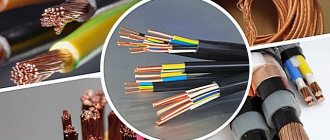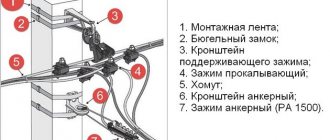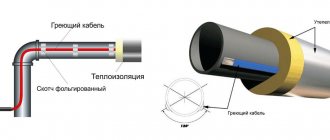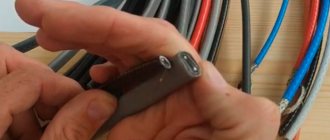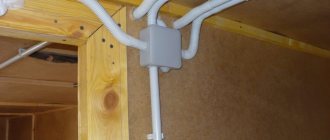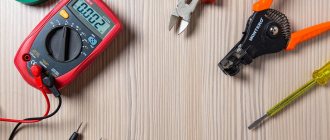Today there is a huge selection of cable products, and not even all electricians can thoroughly understand their designations and names without special literature.
The first question that arises before a consumer who decides to repair the electrical wiring at home is which cable should I choose? Let's consider only those types of cable that most often need to be used when installing and replacing electrical wiring inside an apartment or house. Finding them in construction stores is not difficult.
However, when purchasing, you must know exactly what their letters in the abbreviation mean, when you need to use one or another brand, and whether it is possible to replace one cable with another if one of the types is not on sale.
Cable VVGng and VVGng-LS differences
The first most common and most correct cable option is VVGng and its variety VVGng-LS. The cable has the following design:
It can be single-core or multi-core. In this case, the conductor was single-wire up to a cross-section of 25mm2. Most often it has a flat shape, which is very convenient when placing it in a narrow groove in a vertical position.
And in plastic cable channels it is convenient to lay wires of this particular shape. At the same time, do not forget that there should still be 40% free space in the cable channel after installation.
Emergency cases
In the event of sparks and fire, you should immediately turn off the electricity in the entire apartment and call the fire department or electrician.
Another emergency case is electric shock to a person. If the wiring is faulty, injury can easily result from contact with an electrical appliance, exposed wire, or from a regular outlet. The victim should immediately call an ambulance, and while they are on the way, provide first aid:
- Give oxygen: open the window, unfasten the buttons on clothes and the zipper, sometimes it is necessary to clean the growth cavity.
- The head should be thrown back and the lower jaw should be pushed forward.
- Perform a closed heart massage: clasp your hands together and press your palms on your chest (on the xiphoid process) thirty times.
- Cover the victim’s nose with one hand and blow twice into the mouth.
You need to repeat until your heartbeat and breathing are restored.
You cannot hesitate in such situations; every second of delay can cost a person his life.
Keeping your apartment and house clean is the key to health, good mood and comfort. But it is important to carry out a timely inspection of the condition of the electrical wiring. In fact, it is a vital element of the functioning of a residential building. At the first sign of a malfunction, you need to turn off the power to the house and call a technician.
Explanation of the name
First of all, let's decipher all the letters in the abbreviation. Many people often wonder what they mean?
In the first
means that the insulation is made of polyvinyl chloride material
In the second
The cable sheath is also made of polyvinyl chloride insulation
G
cable Bare, without any protective armor covering
Just to remember, electricians call it among themselves:
Vinyl-Vinyl-Naked
Some brands after VVG have additional letters in their names:
P
stands for “flat”
ng
means that the cable is not flammable, although it would be more correct to say “non-flammable”
A
the cable is not flammable even when laid in bundles
Non-flammable due to the use of special insulation that does not support combustion, both the main core and the outer sheath. During a short circuit, such insulation envelops the wires and prevents them from burning.
Many people mistakenly talk about adding a chalk mixture to the insulation of the cores of a given cable, supposedly to reduce flammability. There's no chalk there.
Only dye is added to the insulation itself, otherwise you won’t get a quality product.
The only purpose for which a chalk-filled mixture can be used is exclusively to separate the insulation from the shell.
To do this, the veins are pre-rolled in a chalk bath during the production process. In addition, this technology helps prevent the cores from sticking together inside the shell.
Remember that the property of not burning a cable is only part of the task. It is necessary that the fire dies out and dangerous combustion products do not spread, and for this it is necessary to displace oxygen from this very zone. The PVC casing of VVGng-LS contains chlorine and other additives that perform this function.
It is because of this that the VVGng-LS brand is primarily recommended for installing wiring inside a house, office, or apartment.
L.S.
this is an abbreviation for Low Smoke, that is, low smoke and gas emissions
Elimination of short circuit consequences
If the search for the short circuit was successful, then it’s time to exhale and start eliminating it. What to do next depends on the extent of the damage to the electrical wiring. Regardless of the situation, before starting any repair work, you should definitely turn off the power to the apartment and make sure there is no voltage.
It is necessary to assess how much the cable insulation was damaged at the time of the short circuit. If there are swelling, darkening or melting, the wire must be replaced. If possible, it is necessary to assess its condition along its entire length.
Connecting wires in the distribution box using terminal blocks
If the wire covering is in order, then the immediate location of the short circuit is removed. The surviving ends of the current-carrying conductors are stripped and connected using Wago terminal blocks, welding, soldering or crimping. In low-current circuits, you can use regular fast twisting at your own risk. However, the PUE (7th edition, clause 2.1.21) does not provide for and does not approve of this method of connecting cables.
Specifications
All technical data of the most used cable sections VVGng-LS, such as rated current, weight, resistance are presented in the tables below:
One important tip - even if you don’t yet have a grounding wire in your house and the system is TN-C and not TN-CS, still always buy only a three-core cable.
This way you won't have to redo all the wiring if you change your grounding system. Well, as a last resort, the third core will always remain a backup if a break occurs on the phase or neutral wire.
The most likely causes of heating
On thematic forums, disputes periodically arise regarding the reasons that cause heating of conductors with zero potential when the phase wires of a household network are in normal condition. Despite numerous discussions on this issue, there are only three factors that can cause the negative impact in question:
- Low reliability of electrical contact.
- Influence of higher harmonics.
- Increased load to zero.
We propose to consider in detail each of the reasons listed above.
Low reliability of electrical contact
This reason is most typical for old wiring made of aluminum wires. The disadvantages of this material have been repeatedly described in other publications on our website, but it would not be amiss to briefly list them once again:
- The formation of an oxide film on the wire, which causes an increase in contact resistance.
- The plasticity of the material requires regular tightening of the joints.
- Overheating of aluminum wire increases its fragility.
Considering that attention is often paid to the electrical contacts of phase wires, the zero bus is often forgotten. As a result, the contact resistance increases over time, it heats up and sooner or later burns out. To be fair, it should be noted that this problem can also occur with copper wires. An example of poor contact with the zero bus in the apartment panel is shown in the photo.
Overheating of neutral wires due to poor contact
It is characteristic that the above problem most often manifests itself in residential panels, and not in electrical points. This is explained by the fact that the contact connections of the wires with the zero bus bear a greater load than a separate socket.
Influence of higher harmonics
With the advent of a large number of electrical appliances equipped with switching power supplies in everyday life and offices, a problem arose with overheating and, as a consequence, destruction (burnout) of the working zero wire. This occurs due to the latter being overloaded with higher harmonic currents. That is, a situation arises in which the zero carries more current than the phase conductors. In this case, the installation of protective devices is often carried out only on the latter.
In old systems, only linear loads were taken into account, in which only the fundamental harmonic was present (In the Soviet Union, and subsequently in the post-Soviet space, this was 50.0 Hz). In accordance with this, it was believed that the load on the phase wires would always be higher than on the working zero. This implied the impossibility of overloading zero more than a phase. Thus, protecting the phases from overheating also ensured zero safety.
With the advent of a large number of electrical consumers creating nonlinear loads, there is an increase in the current flowing through the working zero. This can lead to the latter burning out in old power systems. Examples of household electrical appliances causing nonlinearity:
- Microwave, induction and electric arc furnaces.
- LED and gas-discharge light sources.
- All devices with switching power supplies.
- Inverter electric machines, etc.
To prevent zero loss due to the influence of higher harmonics, changes were made to some regulatory documents. As an example, we can cite GOST 30804.4.30 2013, which requires that in calculations take into account harmonics whose order is from the 40th and higher. In GOST 50571.5.52 2011, it is recommended to select the cable cross-section depending on the most loaded current-carrying core, and the current load of the working zero should also be taken into account.
Unfortunately, the scope of the current article does not allow us to more fully explore the topic of higher harmonics, but we will definitely return to it in one of the subsequent publications on our website.
Increased load to zero
Sometimes you can hear that overheating of the zero wire is associated with increased load due to the connection of a neighbor to the PE bus for the purpose of stealing electricity. This option is interesting, but not feasible. In one of our publications, which described various designs of electric meters, their resistance to various methods of theft of electrical energy was considered. In particular, it discussed the option of using land as a working zero and explained why this method does not work on modern energy metering devices.
As mentioned above, in the neutral working wire the current can exceed the phase current only in cases of higher harmonics. Connecting a neighbor to zero (in your panel) will cause overheating of this wire if, as a result of such actions, poor contact is formed with the common bus.
Residential use
People often wonder, is it possible to use a simple VVGng, without the LS index? The rules, which have changed significantly in recent years, say that for installation inside residential premises, simple VVGng is prohibited.
This brand can only be used outside the building. See GOST 31565-2012 –.
This is explained by the fact that although it does not burn, under the influence of a flame it releases a huge amount of toxic substances. But it is because of combustion products, and not from fire, that most people die in fires.
Lighting. How do you know when it’s time to change everything?
It is necessary to pay attention to lighting fixtures: old chandeliers, sconces, lamps. The weak point of old lighting devices is the cartridges! Over time, the plastic of the cartridges dries out and bursts, the contacts overheat and oxidize, hence all the ensuing problems. Often, due to such sockets, light bulbs explode, or the base is left inside the socket. Replacing sockets in old chandeliers is not a cheap pleasure, as it is a very painstaking job and requires quite a lot of time. It is often easier and cheaper to buy a new lighting fixture.
Cartridge
Be careful with electric current! Don't have the funds to completely replace the wiring? - Do it at least partially. Any improvement in wiring is additional insurance for your safety, which significantly reduces the likelihood of any problems with wiring and will significantly reduce energy costs.
NYM cable differences
The next brand suitable for indoor wiring is NYM cable. This designation is international and came to us from Germany.
The letter N (Normenleitung) means compliance with the German VDE standard - the union of German electricians. Y (Isolierung der Adem aus Polyvinylchlorid) – core insulation material is polyvinyl chloride, just like VVG. M (Mantelleitung) – installation cable with a protective sheath for installation inside buildings and structures
There are also similar names NUM and NUM. These are not fakes at all, as they might seem at first glance. They are produced by the same factories according to their own technical specifications, but without a VDE certificate.
Technical specifications:
NYM can be called a foreign analogue of VVGng, although another brand, VVGz, is closer to it. “Z” is a placeholder.
KG – designed for harsh conditions
Perhaps the best solution for outdoor use is a cable marked KG. It has an insulating layer of rubber based on natural rubber. Moreover, such insulation is used both outside and for the cores themselves. This helps the product maintain high flexibility even in severe frost, and also makes it resistant to ultraviolet radiation - the shell does not crack. Withstands high air humidity. It is suitable for outdoor lighting of cottages, private houses, and enterprises. Can be used in car washes and production areas. It is often the basis for creating extension cords and powering equipment.
Understanding the labeling
- K – cable
- G – flexible
It has copper cores - from 1 to 5 pieces. The cross section can be up to 95 square meters. mm. For example, the 3x4 marking means that the cable is three-core and the cross-section of the cores is 4 square meters. mm. There are also additional letter designations: t – the cable is suitable for tropical zones and rooms with air humidity up to 98%; n – non-flammable with oil-resistant insulation; chl – resistant to cold, withstands frosts down to -60 °C.
What is the difference between NYM and VVGng
Here are the main differences between the two cable brands:
- firstly it has triple insulation
The third intermediate layer, in addition to fire-fighting properties, also restrains mechanical stress between the external insulation and the conductors. This prevents the formation of cracks on them.
True, the manufacturer himself does not consider this third layer of extruded rubber mixture to be insulation. And judging by the test voltage, the insulation itself is somewhat inferior here:
VVGng - test voltage - 3 kV NYM - test voltage 2.5 kV
- secondly, its insulation is gray, while that of VVG is black
For many, categorically black may not be suitable for aesthetic purposes.
- thirdly, it is always round in shape
A plus that few people think about, but the rounded shape of NYM makes it easier to seal the input of this cable into various devices, junction boxes and cabinets.
- and most importantly, the NYM cable is suitable for fire safety for indoor premises only when installed individually!
If you want to lay it in bunches of two or three pieces in one groove or channel, you will have to use the NYMng (A)-LS modification
Just don’t be confused, single NYMs, each laid in a separate corrugation, and running along the surface of a wall or ceiling next to each other, are not considered a bundle. This is exactly how many electricians get around the ban on group installation of wiring of this brand.
Symptoms of the problem
Under normal conditions, network devices should not become hot. If you touch the plastic while electrical appliances are running, the plug, cable or socket will always remain cold. Even a slight increase in temperature warns of problems in functioning.
At the first stages, the processes inside the devices go unnoticed by the user. A person pays attention already when an unpleasant smell of burning or sparks appears. Upon contact, the element produces an electric shock. If the outlet gets hot, there is a problem with the design.
Symptoms of device malfunction Source zen.yandex.ru
If changes are ignored, the device damages the fuses of switched on electrical devices, which leads to the combustion of electronic chips. Automatic protection in the shield is supposed to protect the equipment from troubles, but it wears out over time. If neglected, the problem will cause a fire.
Cable laying features
Of course, this wire does not spread combustion, but this does not mean that it does not burn at all.
Here is a demonstration video about the simultaneous testing of the flammability of two brands when exposed to an external flame. It immediately becomes clear why NYM cannot be laid in bundles and together with each other.
Another feature of this brand, which at the same time can be its disadvantage, is that the cable insulation is afraid of ultraviolet rays. That is why it cannot be laid outside.
VVGng has greater opportunities here. It can be easily used both inside and outside the building. For example, as an input from a pole to a house, or a branch after a SIP wire.
A close relative of NYM, which can be used outdoors and outdoors, since its insulation is no longer afraid of ultraviolet radiation, is the MMJ cable.
Why do many still choose NYM given its relative disadvantages? This is explained by the great convenience when laying it - it is easier to clean, bends at turns, and does not get stuck when pulled through pipes and corrugations.
For a flat VVG cable, you need to make sure that it does not get twisted, but with a round NYM there are no such problems.
How to prevent critical heating of the zero?
Since on the scale of an apartment the influence of higher harmonics is insignificant, we will immediately move on to the problem of poor electrical contacts. If you find a problem area in the apartment panel where the electrical connection is heating up, then first of all turn off the input circuit breaker and make sure that after that the current does not flow. The best way to test is to use a combination of a voltage probe and a multimeter set to AC current.
Once you are sure the power is off, loosen the offending terminal (usually a screw terminal) to remove the wire. Clean it, as well as the clamp. If the panel wiring is made with stranded copper wire, then its ends must be tinned or crimped. After this, you can collect the contact. It should be taken into account that “pinching” the wire with a screw connection is as undesirable as a weak clamp.
Direct contact of copper and aluminum is unacceptable, since these materials form a galvanic couple, as a result of which the electrical resistance of such a connection will increase quite quickly.
If the installation was carried out using thin wires, then it is advisable to replace them. How to choose the right cross section depending on the load current is described on our website.
Phase imbalance protection
The best option for this case is to install a voltage relay.
Voltage relay
This device will provide protection against both voltage drops and excessive increases. As an alternative solution, we can suggest installing a stabilizer for the entire apartment. Despite the higher cost, the advantages are obvious - “sag” or overvoltage will not cause a power outage.
Life time
The estimated service life of VVG and NYM cables is at least 30 years.
At the same time, the wording “not less” means that if this cable is under 100% load in unfavorable conditions, it must work for AT LEAST 30 years.
And if there are the most ordinary conditions and the absence of a nominal load, then maybe all 50! It is these two main brands of cable, discussed in detail in the article, that are the most suitable and popular for installing electrical wiring, connecting sockets, switches and lighting.
There is another brand different from the two above that you may need in small quantities. But this is not a cable, but a wire - PV-3.
It is flexible, multi-core, easy to bend in small spaces and convenient to connect to machines via NShVI lugs. That is why it is used in the assembly of electrical panels.
Well, in the end, we will give a decoding of all the meanings of the letters in the cable brands, which are widely applicable in our electrical networks.
Comparison of parameters
It is more clear to compare data by combining the information in one tabular form.
| Technical characteristics, standard size 3x4 | Meaning for | |
| NYM | VVGng | |
| Rated AC voltage with a frequency of 50 Hz, V | 660 | 660 |
| Temperature | ||
| Range of normal cable operation, °C | -50 ÷ +50 | -50 ÷ +50 |
| Maximum permissible temperature, no more, °C | 70 | 70 |
| Emergency long-term, no more than 8 hours, increase no more than °C | 80 | 80 |
| Permissible during short circuit for up to 4 sec, no more, °C | 160 | 160 |
| Air temperature at which installation without preheating is allowed, no colder, °C | -5 | -15 |
| Trial | ||
| Test voltage, V | 2000 | 3000 |
| Test time, min | 5 | 10 |
| Mechanical | ||
| Nominal insulation thickness | 0.8 | 0.7 |
| Nominal thickness of intermediate layer | 0.4 | No |
| Nominal Sheath Thickness | 1.6 | 1.5 |
| Weight of 1 kilometer of cable | 270 | 194 |
| Cable cross-sectional shape | Round | Round Flat |
| Permissible bending radius, outer diameters of the cable, no more than times | 4 | 7.5 |
| Possibility of sealing when entering equipment | Yes | No |
| Does not spread fire during installation, | Single | Group |
| The ability of the cable to draw in water, hygroscopicity | No | Yes |
| Sheath resistance to ultraviolet radiation | Below | Higher |
| Convenient cable termination | Higher | Below |
| Outer shell color | Light gray | Black |
| Nominal service life, not less, years | 30 | 30 |
| Price | Higher | Below |
There are differences in characteristics across many positions. The question of whether to purchase an NYM or VVGng cable cannot be resolved without a careful comparison of the inconsistencies that give different properties during installation and operation:
- Almost identical temperature ranges. The difference is that the plastic compound allows laying VVG without preheating at a lower air temperature, -15°C. NYM composite rubber does not allow operation below -5 degrees;
- Electrical tests of domestic products are more severe. 3000 volts for 10 minutes, versus 2 kV for 5 minutes. The testing requirements are explained by the thick insulation and sheath of the imported cable, and the presence of an additional middle layer of protection. These circumstances influenced weight gain;
- Soft vinyl and a layer of elastic rubber increased the flexibility of the NYM. This allows it to be laid individually with a smaller radius, making it easier to work on curved sections of the route. Of great importance is the ability to seal the insertion points of the shell in explosive areas. Rigid VVGng with a shell made of modified plastic has high fire-fighting properties, allowing for laying in bundles. Unlike its European counterpart, it is easier to withstand laying without UV protection outdoors;
- A layer of coated rubber, providing tightness, allows use in very wet places. It also makes it easier to cut NYM ends during installation. The subjectively more pleasant light color of the hose is easily marked with a felt-tip pen or marker when laying;
- The cost of VVGng is lower.
Benefits of Copper Wiring
Copper electrical wiring is resistant to bending, does not break off, during long-term use it has better electrical conductivity, oxidation of the end wires does not affect performance in any way. It is worth noting that according to the new rules for construction and installation work, only copper electrical wiring is laid, aluminum wiring is not taken into account due to the above-mentioned shortcomings.
Not everyone can carry out a complex reconstruction of electrical wiring, complete or partial, on their own. If you are not able to carry out the transformation, I do not recommend inviting the first electrician you come across. To properly replace electrical wiring, hire a competent electrician.
When installing new wiring, the owner of the premises strives to do everything so as not to return to this operation, therefore, when carrying out repairs or during the construction process, he is always interested in how long the service life of the wire is. At the same time, confusion often arises in defining the very concept of service life - designers, cable manufacturers and electricians operate with different numbers. Therefore, first, let’s define the terminology.
Copper or aluminum?
In the past, for reasons of economy, cables with aluminum conductors were widely used for home wiring. Today the priority is copper. Aluminum has a high electrical resistance, therefore, in comparison with copper, to ensure the same current load it is necessary to use wires of a larger cross-section.
The main parameters of cables with copper and aluminum conductors for hidden wiring of networks with a voltage of 220V are given in the table:
| Section, mm2 | Current, A (copper) | Power, kW (copper) | Current, A (aluminum) | Power, kW (aluminum) |
| 1 | 15 | 3,3 | ||
| 1,5 | 17 | 3,7 | ||
| 2,5 | 25 | 5,5 | 19 | 4,2 |
| 4 | 35 | 7,7 | 28 | 6,1 |
| 6 | 42 | 9,2 | 32 | 7 |
| 10 | 60 | 13,2 | 47 | 10,3 |
Price policy
Of course, price is the main difference and the reason for choice. Pricing depends on the quantity and quality of materials used. In the case of the power cables under consideration, high-quality materials are used, up to tubular PVC braid, but their quantity is different. In the case of VVGng-LS there are more of them, and the production method is more complicated. These two factors influence the price, which, by the way, is higher, by approximately 12%, in relation to the above-mentioned VVGng.
VVGng(A)-LS
Core cross-section
Unlike VVGng-LS, the VVGng cable has a smaller core cross-section, exclusively in relation to four-core and five-core power conductors. For example, four-core VVGng-LS has a cross-section of 70 mm2, and VVGng - 90 mm2. The same, but already five-core conductors, have the following cross-sections - 185 mm2 and 120 mm2, respectively.
